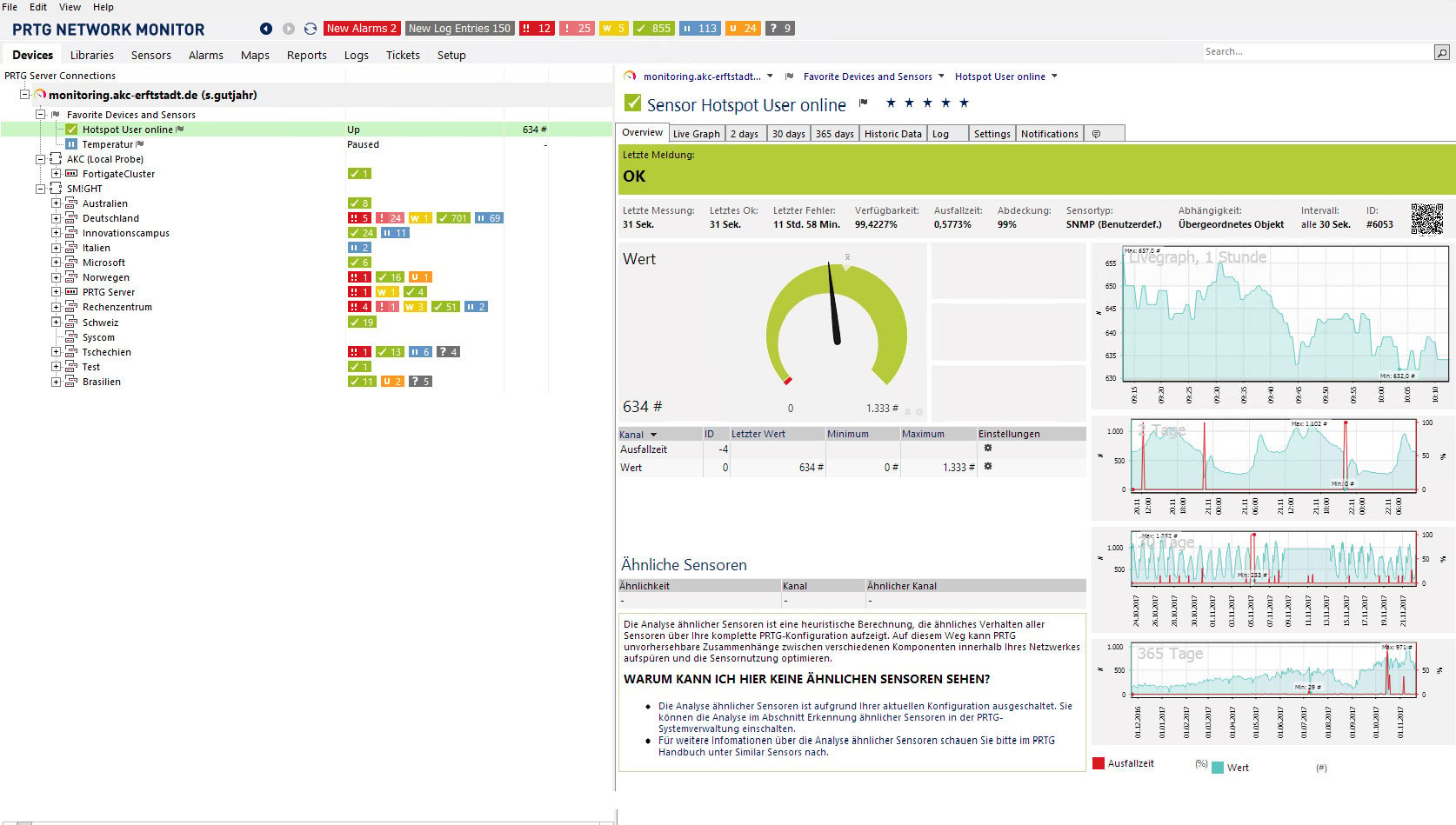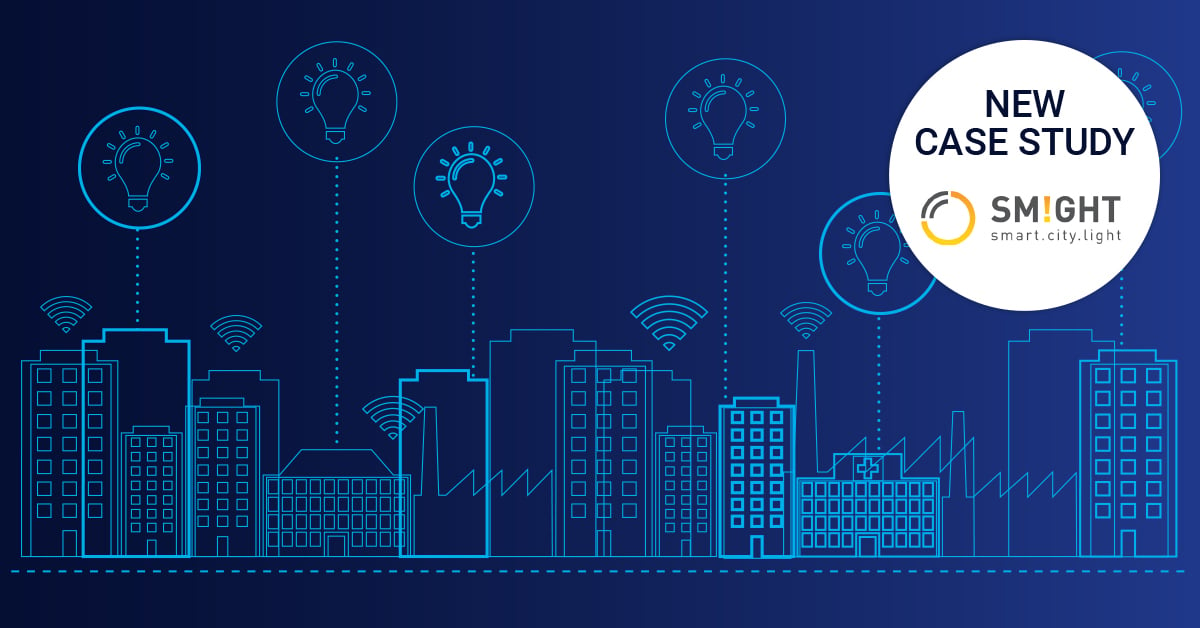iAbout SMIGHT Smart City

In 2014, EnBW invested its 100+ years of energy-supply and street lighting expertise in an innovative new project to develop the streetlight of the future. The result was the startup SMIGHT.
Since then, the startup and its 20 employees have successfully implemented SMIGHT Smart Cities in Germany, Switzerland, Norway, and Australia. Within no time, SMIGHT has developed from a smart streetlight into a one-of-a-kind system. With its various areas of expertise (base, air, tools, and IQ), SMIGHT develops lighting, environmental sensor technology, e-mobility, public Wi-Fi, and many other solutions.
“Our customers know that we use PRTG to keep an eye on the network, and that we can therefore quickly detect and inform them of any problems that might arise.”
Simon Gutjahr, IT Operations Manager at SMIGHT
From development to everyday operations: Network monitoring helps make sure Smart City technology never fails
Founded in 2014 by EnBW, the startup SMIGHT develops smart solutions for cities on several continents. Its main components are streetlights, which are found at regular intervals and are connected to the city’s power supply. The startup uses smart streetlights and multi-functional poles to transform a city into a Smart City. This not only involves installing new equipment, but also integrating modern technology into existing systems. “The connection to the Internet is the primary building block of the central nervous system of an urban infrastructure,” declares Simon Gutjahr, IT Operations Manager at SMIGHT. “As such, it is also the basis for the integration, networking, and controlling of future technologies.”
SMIGHT solutions include lighting, e-charging stations, Wi-Fi hotspots, and emergency intercoms. In addition, the startup develops sensor technology that records data related to traffic and the environment.
Currently, the SMIGHT network is made up of more than 600 Wi-Fi hotspots and 150 electric-vehicle charging stations around the world. Understandably, keeping an eye on a network of this scope and size can be a challenge for SMIGHT's IT and engineering teams: systems can fail at any time, such as when LTE or LAN router connections are interrupted. “When a problem arose, we had a really hard time identifying the source of the error and determining whether it was a temporary or permanent malfunction,” says Gutjahr. “Many people rely on our solutions. Our towers, for example, have emergency call functions which can even help save lives in an emergency. It’s therefore extremely important that we keep our systems available at all times.” Faced with its limitations, the IT team began to entertain the idea of using a monitoring tool to permanently monitor its networks, as well as all its components.
Learning from experience
The IT team at SMIGHT already had specific requirements for its monitoring software: for example, the tool had to be easy to configure and use, as well as allow for the straightforward and centralized monitoring of its entire network. While shopping for a tool, the startup therefore focused on usability, features offered, and customization possibilities. This enabled Gutjahr and his team to save precious time during their search for a suitable solution.
Since the company’s data center is operated by an external IT service provider that was already using PRTG Network Monitor as their monitoring tool, SMIGHT was able to quickly learn the ins-and-outs of PRTG. “We took a look at PRTG, and were immediately impressed by the tool’s simple configuration, user-friendliness, and range of features. The fact that our IT service provider already used PRTG was, of course, a huge bonus – we were able to make use of their license, and conveniently set up our own PRTG installation in a single day,” explains Simon Gutjahr, describing the startup’s process of selecting and implementing a tool. The operator of the data center created an instance for SMIGHT that included all the startup’s products and systems.
“We took a look at PRTG, and were immediately impressed by the tool’s simple configuration, user-friendliness, and range of features. The fact that our IT service provider already used PRTG was, of course, a huge bonus – we were able to make use of their license, and conveniently set up our own PRTG installation in a single day.”
The challenge of a complex infrastructure
Despite the ease with which the IT team was able to select and implement its monitoring tool, it still faced another challenge: the IP addresses and locations of is internationally distributed devices and systems had to be entered manually into PRTG. The employees took it one step at a time – first the country, then the municipality, and finally each individual installation (and the systems integrated into each). “Even though it was a lot of work at first to enter each individual system, we now have a comprehensive overview of all our systems and installations. This makes our day-to-day work much easier,” explains Simon Gutjahr.
SMIGHT currently uses around 1,500 PRTG sensors to keep a constant eye on its Linux-based customer installations (600 Wi-Fi hotspots and 150 charging stations), as well as its entire data center. In the data center, it monitors both virtual servers (such as Azure Server) and physical servers. In addition, classic IT systems are integrated into the monitoring environment so the startup can quickly uncover malfunctions. These include VPN routers for tunnels, databases, router configuration servers, ownCloud, Jira, and the cloud database for SMIGHT IQ sensor values. With the help of PRTG custom sensors, the IT team can also see which users are currently using a Wi-Fi hotspot.
Various aspects must also be monitored during the operation of individual smart streetlights: pings of the routers, runtime, load controllers, sensor controllers, the availability of sensor values in the cloud, and even (in some cases) thermal imaging cameras. Sensors were installed in each charging station to not only allow the company to be informed if a multifunctional tower has a problem, but also to localize the problem at once. In this way, if a problem does arise, the IT manager immediately knows whether it lies with the sensor controller, the load controller, or the router. As a result, the IT team can step in right away to prevent entire systems from malfunctioning.
 Monitoring provides for transparency
Monitoring provides for transparency
SMIGHT strives to be as transparent as possible when working with its customers, who are representatives of the local communities. “Our customers know that we use PRTG to keep an eye on the network, and that we can therefore quickly detect and inform them of any problems that might arise. But we also wanted to provide them with a real-time overview of their devices, which they could access whenever they liked. We therefore let them create their own profiles with read access rights,” states Simon Gutjahr.
Since admin rights to the PRTG server resided with the operator of the data center, they were tasked with creating individual profiles with links, usernames, and passwords. Customers can now access customized dashboard maps via a variety of user interfaces, such as the web interface, the PRTG Enterprise Console, and the Android app.
SMIGHT is considering upgrading its PRTG license to be able to respond to customer requests more autonomously in the future, as well as to up its performance to meet the needs of the growing company. “We’re currently working closely with Paessler to explore ways in which PRTG can accommodate our growth,” explains Simon Gutjahr. For example, the IT department would also like to use the application programming interface (API) to simplify the process of entering systems in the future. This interface makes it possible to access information on software, a framework, or an operating system, and thereby standardizes the sharing of information. For system admins, this has many advantages: in particular, they can modularize and customize the monitoring tool to meet their own specific needs.
PRTG Sensor Contest: Smart City monitoring wins a prize
Over the years, we’ve learned of many interesting ways that our customers use PRTG. For example, some hospitals monitor the refrigerators in their blood bank, while one company’s IT staff is notified whenever their boss arrives. In order to promote innovative ideas and demonstrate the capabilities of network monitoring, we launched the PRTG Sensor Contest. During the contest, customers describe the unique ways they use PRTG, including their use of custom PRTG sensors. One of these participants was the EnBW startup SMIGHT.
SMIGHT not only uses PRTG to monitor technology that is already installed and in use, but also during development. “System failures can occur for a variety of reasons; one such reason is often a material or manufacturing error. To rule out such errors, we also use PRTG during the development of our solutions. In addition to using the software’s standard features, we also set it up to provide us with information on the temperature in the casing of a product (for example). If the tool notifies us of an anomaly, we can immediately step in to fix the problem – as well as take the error into account while developing technologies in the future,” concludes Simon Gutjahr.
Thanks to its versatile use of the monitoring solution and the complex monitoring of its internationally distributed network, the company was awarded a prize in the PRTG Sensor Contest.
Conclusion
For SMIGHT, PRTG is the perfect tool for monitoring its internationally distributed systems. During the development of the company’s smart solutions, the tool helps eliminate potential problems and ensure everything runs smoothly. PRTG also provides the company with a real-time overview of all its systems, and immediately alerts the IT team whenever a predefined threshold value has been exceeded. By deploying a variety of different PRTG sensors, the IT manager can pinpoint exactly where the problem lies. PRTG also makes it easier for the SMIGHT team to work with its customers by providing maps that allow the team to clearly explain to customers how it monitors the systems locally, and by displaying the respective availability as percentages.
 Published by
Published by 












